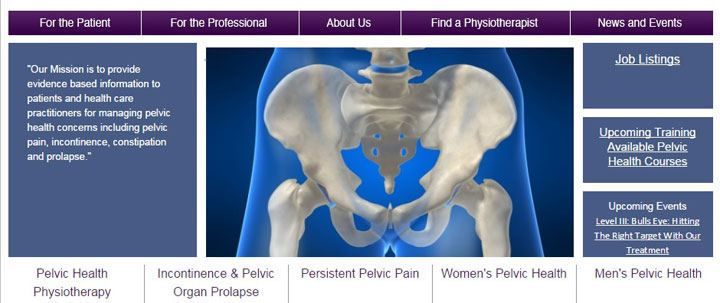TORONTO – Painful sex and unintentional urine leaks aren’t necessarily topics you’d bring up at a cocktail party. But maybe they should be.

A specialized physiotherapy gaining popularity in Canada hopes to demystify these somewhat awkward bodily dysfunctions and provide non-surgical solutions.
Pelvic floor physiotherapy—sometimes likened to “internal Pilates”—aims, as its name suggests, to strengthen the all-important muscles lining your pelvic floor.
These are the muscles you use whenever you control an urge to urinate or defecate; they support the uterus, bladder and rectum. Both men and women have them, and they also help facilitate birth in women.
But if you thought basic Kegels, contracting and relaxing of your pelvic muscles, were enough to keep your pelvic floor happy, be careful: Not only are they not appropriate for everyone, you could be doing them wrong and harming the muscles you’re trying to help. (Who knew?)
Signs you’re doing Kegels wrong:
- Bearing down;
- Clenching butt muscles or leg muscles;
- Holding your breath;
- Contracting muscles without being able to let go;
- Other people can tell you’re doing them.
But don’t feel bad if you’ve been doing Kegels wrong: You’re far from the only one.
“The research shows that more than 50 per cent of women don’t do their Kegels properly,” says physiotherapist Nelly Faghani.
“The only way of really knowing if you’re doing it properly is by having an internal evaluation of these muscles.”
Don’t freak out. That internal evaluation could be a gloved finger in your vagina or rectum, or a biofeedback machine that can be inserted to record whether the muscles are activating or not.
Faghani runs a detailed website with colleague Carolyn Vandyken called Pelvic Health Solutions. Faghani and Vandyken have been credited with introducing and advancing skills in this arena.
In addition to evaluating the correctness of your Kegels, pelvic floor physiotherapy can treat painful symptoms or involuntary urination. It can also be a prenatal vaginal-strength strike for pregnant women or help men about to have their prostates removed recover more quickly. (If the men start exercising proper contraction of the muscles before surgery, they tend to do better following prostate removal).
Faghani says there are two typical problems with pelvic floor muscles:

Get weekly health news
HYPOTONIC – Your pelvic floor muscles are too weak. This can make you pee involuntarily and contribute to pelvic organ prolapse – when an organ like your bladder, uterus or rectum descends to sit lower than it should.
HYPERTONIC – Your pelvic floor muscles are too tight. This can contribute to things like urgently needing to urinate or defecate, chronic pelvic pain and chronic prostatitis (inflammation of your prostate gland).
“The biggest problem is that everyone thinks if you come see a physiotherapist—even with this training—they’re just going to teach you Kegels. But when you look at core, when you do Pilates, core is not just the pelvic floor; it’s the diaphragm, it’s the transverse abdominals, the deep abdominal muscles, your multifidus—which are muscles in your back,” said Faghani.
“You need to make sure that everything is strong but that they’re also coordinated, that you have the right pressure systems being created—the right ones are coming on, turning off,” she said.
And even if you are doing Kegels properly, if your muscles are too tight you need to fix that first.
“You can’t start strengthening those muscles until you lengthen them,” Faghani said. “If you had a cramp in your hamstring, it would be weak and tight. What would you do first? You would stretch it.”
Dr. Lesley Carr is an associate professor at University of Toronto’s department of surgery and Sunnybrook Health Sciences Centre. She credits Faghani and Vandyken with an “explosion” of pelvic floor rehab.
But pelvic physiotherapy isn’t for everyone.
“There are some patients that are just not comfortable with repeated vaginal [or rectal] examinations, even though it’s in a therapeutic realm,” Carr said.
In addition, Carr said painful symptoms can be amplified at the start of treatment, much like a first back massage could hurt at the time and be sore afterwards.
But Faghani argues proper pelvic floor maintenance can keep people active and independent for longer.
“So many people think that incontinence is a normal part of aging. It’s not: it’s common. One in three women have incontinence; one in nine men,” she said.
For lists of physiotherapists who practice pelvic floor rehabilitation in Canada, click here and follow the menu on the left







Comments